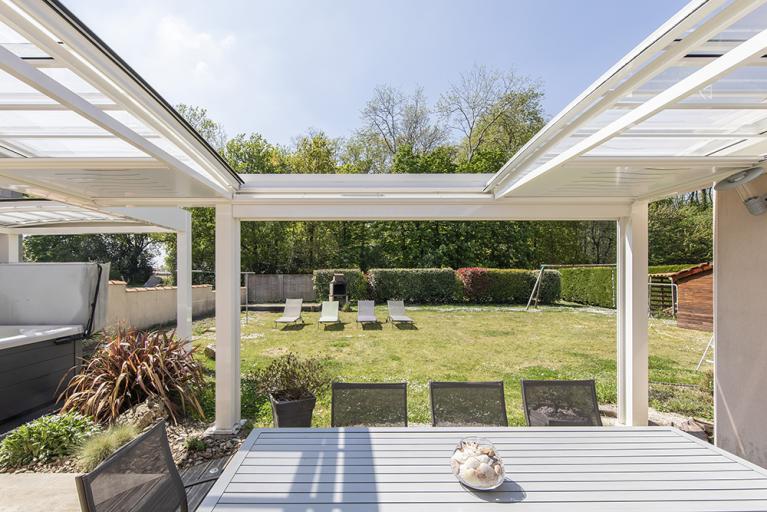Which virgin vine to choose for a pergola?
To shade your garden, you've decided to install a pergola. You've chosen the location and the building materials, so all that's left is to decide what you want the roof to look like. If you want to create a green roof, you have several options. One of them is to grow a virgin vine. Decorative and easy to maintain, it's very popular with house and pergola owners. Find out which virgin vines to choose!
The virgin vine: what is it?
Le terme de vigne vierge désigne toute une série de plantes grimpantes, plus ou moins proches de la vigne. Les trois types les plus connus sont Vitis, Ampelopsis et Parthenocissus. Les Vitis sont de véritables vignes à raisin. Leur feuillage caduc est vert en été, prend une belle couleur orange, rouge et jaune en automne et disparaît en hiver. Contrairement aux idées reçues, les vignes ornementales n'abîment pas la pergola sur laquelle elles poussent ! La vigne vierge peut être enroulée et fixée à la pergola grâce aux petites ventouses situées à l'extrémité de ses vrilles. Mais évitez de l'utiliser sur la peinture ou le plâtre !
The virgin vine Parthenocissus, the best-known vine
Robust and highly decorative, this vine is native to North America and Asia. It clings to the ground with tendrils and suckers. Its leaves take on an attractive purple colour in autumn. To grow and flourish, the Parthenocissus virgin vine needs rich, well-drained soil and a little shade. It can grow to between 7 and 12 metres tall.
Here are some interesting varieties for your pergola:
- Parthenocissus tricuspidata atropurpurea, with burgundy-red foliage in summer and leaves 20 cm long. This vine is resistant to temperatures as low as -20°C. Ideal for pergolas in colder climates;
- Parthenocissus tricuspidata Veitchii is the most popular, with evergreen leaves measuring 10 cm, green in summer and purple in winter. It is easy to grow and produces dark, non-edible fruits in summer, which are a real eye-catcher;
- Parthenocissus henryana (Henry's virgin vine) is a virgin vine from China. If your soil is rich and clayey, it will grow quickly;
- Parthenocissus quinquefolia Star Shower is also known as the ‘variegated virgin vine’. Variegated, because its foliage offers a pretty mix of white, pink, green and red colours. Its deciduous leaves measure between 8 and 20 cm and can withstand all types of exposure. It grows very quickly;
- Parthenocissus quinquefolia Engelmannii is an evergreen climber with fine foliage. Widespread in Canada and North America, it can withstand temperatures as low as -25°C.
Vitis, the real ornamental vine
Also grown for grapes, the Vitis vine is highly decorative. Its tendrils make it easy to attach to your pergola. There are several types of real Vitis vine. Most are native to Asia and grow to between 6 m and 12 m when fully mature. They produce black or very dark, non-edible fruit. The climate needs to be sunny and slightly shady to grow Vitis.
The best-known ornamental vine is Vitis Coignetiae (or Coignet vine). It has won an award from the Royal Horticulture Society. Like all wine vines, it is a member of the Vitaceae family. Common in cold, damp regions, it can withstand temperatures as low as -15°C. Its leaves turn from light green to red and fall off in winter. It will gently creep into your pergola, lining the posts and the roof.
Berry vines: Ampelopsis
Smaller than its cousins, the ampelopsis virgin vine produces small, bluish, non-edible berries. This vigorous climber grows to around 5 metres when fully mature. Undemanding and hardy, it can be grown at temperatures as low as -15°C. Small green flowers bloom in spring, giving way to highly decorative berries that are much appreciated by birds.
Plant a virgin vine for your pergola
You've chosen your vine to adorn your pergola. Now it needs to be planted and maintained. Did you know that, planted and pruned correctly, a virgin vine can last 50 years ? Ideally, plant the vine during its resting period, i.e. when its leaves have fallen. But wait until the frost-free period, in November or March. Dig a hole about 40 cm wide next to one of the pillars of the pergola, then add pebbles for drainage. Put some soil in the bottom of the hole. Remove the vine from the ground and carefully untangle the roots. Place the plant on the soil and fill in with the remaining soil, then tamp it down. Because virgin vines grow relatively quickly, from the second year you can prune the vine to between 5 and 8 eyes (an eye is a bud that has formed but not yet developed). You can tie the vine at certain points to guide it to the desired location.
Read all the articles in the magazine
You have a project?
Would you like a personalised 3D study and a free quotation? Contact us by clicking below.
AKENA is...
Over 40 years of experience
Founded in 1981 by one man, we now have more than 500 employees dedicated to making your project a success.
Made in France
A historic site and two factories covering more than 25,000 m² in Dompierre-sur-Yon in the Vendée region (85)
Innovative and tailor-made products
At AKENA, we are brimming with new ideas to improve and enhance our products.
The European leader in conservatories, pergolas...
But not only! AKENA also offers a complete range of carports and pool houses.
